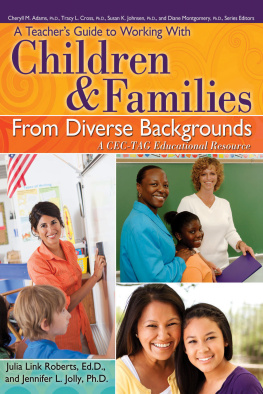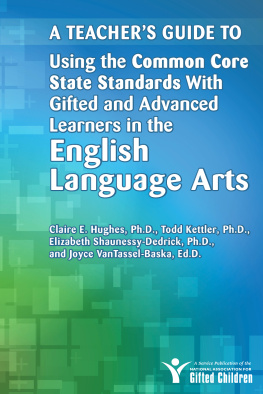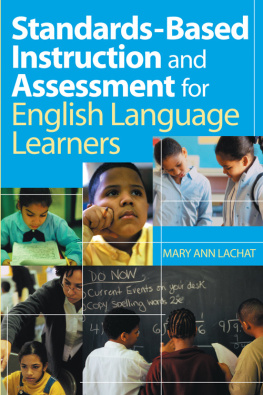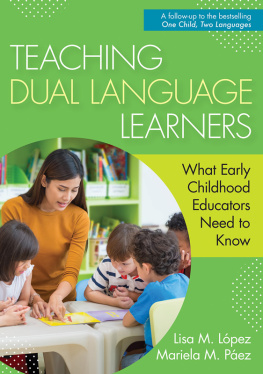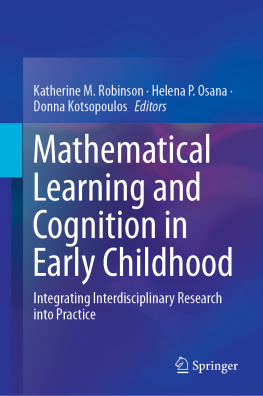Young Learners
Diverse Children
Celebrating Diversity in Early Childhood
Virginia Gonzalez
Foreword by Eugene E. Garca

Copyright 2009 by Corwin
All rights reserved. When forms and sample documents are included, their use is authorized only by educators, local school sites, and/or noncommercial or nonprofit entities that have purchased the book. Except for that usage, no part of this book may be reproduced or utilized in any form or by any means, electronic or mechanical, including photocopying, recording, or by any information storage and retrieval system, without permission in writing from the publisher.
For information:
 | Corwin
A SAGE Company
2455 Teller Road
Thousand Oaks, California 91320
(800) 233-9936
Fax: (800) 417-2466
www.corwinpress.com | SAGE India Pvt. Ltd.
B 1/I 1 Mohan Cooperative
Industrial Area
Mathura Road, New Delhi 110 044
India |
SAGE Ltd.
1 Olivers Yard
55 City Road
London EC1Y 1SP
United Kingdom | SAGE Asia-Pacific Pte. Ltd.
33 Pekin Street #02-01
Far East Square
Singapore 048763 |
Printed in the United States of America.
Library of Congress Cataloging-in-Publication Data
Gonzalez, Virginia.
Young learners, diverse children: celebrating diversity in early childhood/Virginia Gonzalez; foreword by Eugene E. Garcia.
p. cm.
Includes bibliographical references and index.
ISBN 978-1-4129-6813-3 (cloth)
ISBN 978-1-4129-6814-0 (pbk.)
1. Early childhood educationUnited States. 2. Multicultural educationUnited States. 3. Education, BilingualUnited States. 4. Children with social disabilitiesEducationUnited States. 5. Educational tests and measurementsUnited States. I. Title.
| LB1139.25.G657 2009 |
| 372.21dc22 | 2009017324 |
This book is printed on acid-free paper.
09 10 11 12 13 10 9 8 7 6 5 4 3 2 1
| Acquisitions Editor: | Jessica Allan |
| Editorial Assistant: | Joanna Coelho |
| Production Editor: | Libby Larson |
| Copy Editor: | Codi Bowman |
| Typesetter: | C&M Digitals (P) Ltd. |
| Proofreader: | Caryne Brown |
| Indexer: | Jean Caselegno |
| Cover and Graphic Designer: | Michael Dubowe |
Contents
Eugene E. Garcia
Lists of Figures and Tables
FIGURES
TABLES
Foreword
P resently, one in three children eight years old or younger living in the United States is of linguistically and culturally diverse origins. Current estimates suggest that these children are raised in home environments where variable amounts of English and a second language are spoken. However, educational skills and achievement lag significantly for this population, creating an unacceptable achievement gap at the beginning of kindergarten, which grows even further by the end of third grade. Considering the growing size of this young-child population and the large number of them being raised in multilingual environments, it is critical that practitioners address basic questions related to language, culture, cognition, and educational opportunity. This book provides a synthesis of empirical work, which spans several decades, and conceptual frameworks associated with the linguistic development and the early education of young children. Linguistic, psycholinguistic, anthropological, psychological, sociological, and educational contributions that underscore research and practice are reviewed. Emphasis is placed on the practices associated with educational concernsincluding teacher competencies, instructional strategies, curricular content, programs, parent involvement, and related policy. In accordance with the literature reviewed, the author offers specific educational-practice alternatives that have demonstrated achievement enhancements for these children.
Young linguistically and culturally diverse children age zero to eight years old are currently the largest and fastest growing population in the United States (Hernandez, 2006; Hernandez, Denton, & Macartney, 2007). As educational programs, policies, and practices move forwardespecially those targeting the youngest groups of childrenit is important that relevance and appropriateness continue to be resonating themes. But what can be concluded about a large population of children with diverse language and educational experiences at home and in school? What can be ascertained from the empirical literature, theory, extant programs, and policies associated with language and early learning for young Hispanic children? And what home and school factors are important to the differences in early cognitive development and educational well-being? This book explores these questions in a systematic fashion, relying on current theory and evidence with a focus on educational practice.
Because language is a central feature to the cognitive development and early learning for this population (Garca, Jensen, & Cullar, 2006), topics explored in this book are linked to questions of language use and practice. Bilingualism, second-language learning, and related issues, therefore, appear and reappear throughout this synthesis. The author recognizes that not all these children are English-language learners. Many are raised in English-only homes. Moreover, these children represent various racial groups, national origins, social classes, geographic locations, and immigrant generations. Although the author makes the incredible diversity found within this group very clear, there are general trends, patterns, and themes significant to the students as a whole. These are important to understand, as efforts are made to improve educational opportunities for this young, diverse set of children. To avoid gross generalizations, the book addresses key characteristics of this group of children in terms of proportional representation and provides, where possible, descriptions of samples of children in the studies reviewed. As in most reviews, the evidence must be weighed, critiqued, and understood in its proper context where applications are made to individuals or small groups.
A review of this sort is likely to be of most use to practitioners and those that professionally develop them. In some cases, policymakers and researchers can profit from it. Our hope is that discussing research findings and relevant theories while focusing on educational practices will allow appropriate examination of what we know and that if implemented that knowledge base can make a difference in student achievement and overall well-being. Language and its many partsphonology, morphology, syntax, pragmatics, vocabulary, word literacy, text literacy, and reading comprehensionmust be analyzed and understood not only in terms of mechanics (e.g., word attack, reading fluency) but also in terms of context (e.g., person-to-person interactions, relationships, activity settings). This necessitates an analysis of culture, which is inherent in language. Although several studies have described the cultural context in which young children from linguistically and culturally diverse backgrounds use and develop language, few have made the conceptual and methodological links necessary to understand how home and school contexts (including differences between contexts) influence early literacy and learning outcomes (Rueda, August, & Goldenberg, 2006).
Next page

